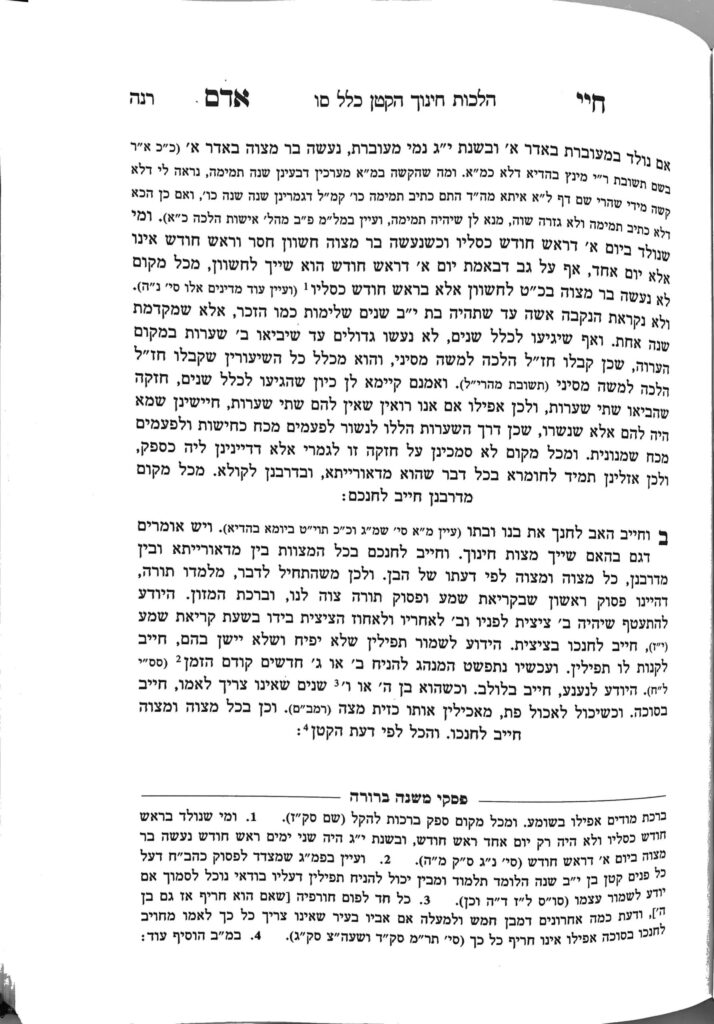1
We are continuing in siman 2. The Chayei Adam continues listing some examples of the proper age to begin chinuch in specific mitzvos:
When a child reaches the age to do na’a’nuim, the father is chayav to buy him arba minim. There are two parts to na’a’nuim, the order of the directions in which to shake, and the actual na’a’nuah itself (bringing forward and backward, and doing kiskus, shaking). Before that time, there is no mitzvah to buy the child a set of arba minim. However, if the child is excited from the purchase of arba minim, that in and of itself may have an element of chinuch to it, as it trains the child to be excited for mitzvos.
When a child is 5 or 6, they are ready to eat and sleep in the sukkah. The Gemara explains that a child is only chayav in sukkah from the age that they no longer need their mother during the night. Since she is not chayav in sukkah, she actually may not be there at night, and it would not be healthy for the child to experience that separation should the child need her. The age at which a child is ready depends on the child, and 5 or 6 is the Chayei Adam’s general approximation.
When a child is able to eat a kezayis in the time of achilas pras, they should eat a kezayis of matzah.
The Chayei Adam concludes this siman by writing that these are just examples, but one can take the rules understood through these examples and apply them elsewhere. For example, regarding the mitzvos of Shabbos, once the child understands the concepts of kiddush and havdalah, they should be included in those mitzvos. (The issur to eat or drink before kiddush and havdalah are separate, and we will address them later.)
Let us go back to some of the examples brought by the Chayei Adam. The first example, limud hatorah, is different that the other examples, because it is a mitzvah deoraysa. The mitzvah is to teach the child in a way that the child will know the pesukim clearly and well, which, at their level, is generally a basic understanding of what the pasuk is saying, and not deep thoughts.
There is a machlokes amongst the poskim whether reading torah she’bichsav without understanding it is considered a mitzvah, but that is considered a chiddush and the assumption is that the primary mitzvah is to learn it with understanding. A child does not need to know every Rav Chaim Brisker on the pasuk; rather, it is important to ensure they understand the basic message the pasuk conveys.
However, there is a benefit to teaching a child to speak the words of the pasuk even before they understand, because it gets them used to the pesukim. Therefore, I think the Chayei Adam means that the chiyuv limud hatorah begins from an earlier age than the age at which they would understand the basic message of the pasuk, in order to get them used to the words of the pesukim before they even understand what they are saying.
Summary
The parents’ chiyuv chinuch applies to all mitzvos, deoraysa and derabanan, at the appropriate times that a child is ready to perform them properly. The Chayei Adam gives some examples:
Torah: from when a child is able to speak–even before they understand–in order to get used to the words of the pesukim;
Tzitzis: from when a child is able to keep the tzitzis strings positioned properly, and follow the correct procedure for shema;
Tefillin: from when a child is able to wear them with the appropriate kedusha. However, nowadays we wait until the weeks before a child’s bar mitzvah;
Lulav: from when a child can follow the procedures of na’a’nuim and kiskus;
Sukkah: from when a child does not need their mother overnight;
Matzah: from when a child can eat a kezayis bichdei achilas pras.



